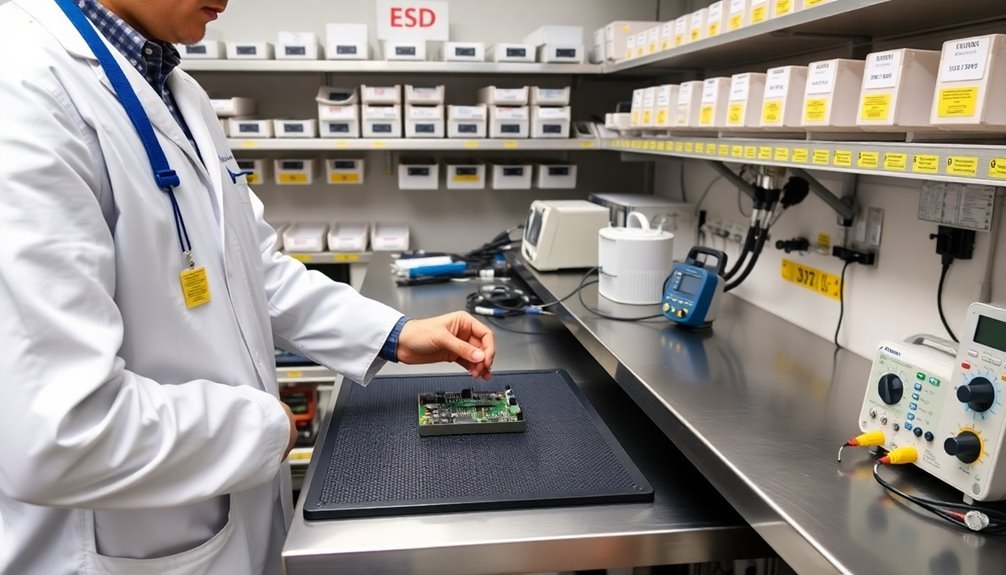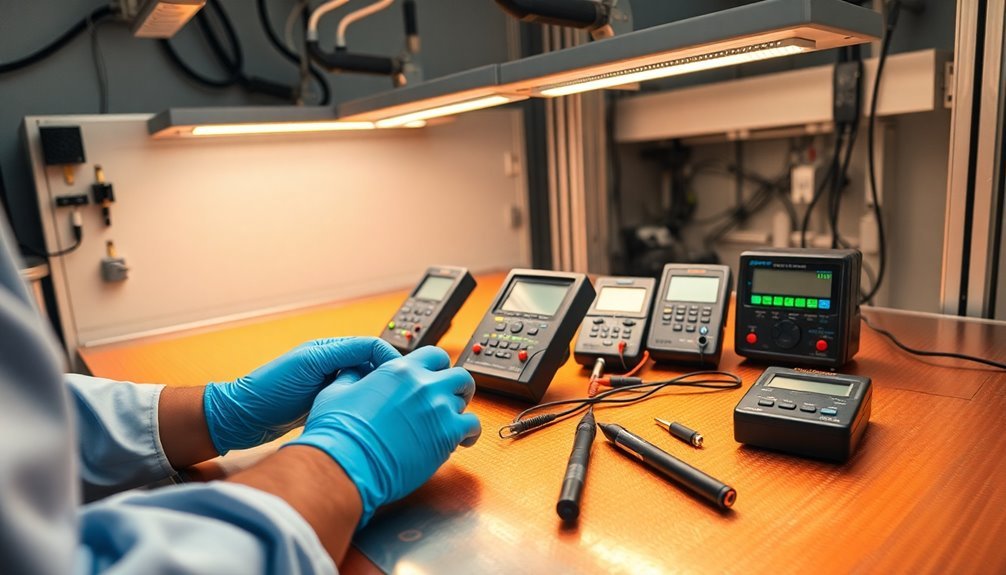You'll find three essential electrical safety programs that can dramatically improve your skills as an electronics technician. The ESD Certification Program provides thorough training through online classes and hands-on assessments, covering fundamental basics and control fundamentals for $1,950. Static Control Training combines theoretical knowledge with practical experience in handling techniques, measurement instruments, and safety protocols. Advanced ESD Protection Techniques teaches specialized circuit design and protection strategies aligned with industry standards. These programs can reduce equipment failure rates by up to 85%, and there's much more to discover about their specific benefits and applications.
ESD Certification Program Fundamentals

Technicians pursuing ESD certification can access a thorough program consisting of three online classes and a knowledge assessment test. You'll learn essential topics including the basics of ESD, measurement techniques, equipment operation, and control program fundamentals through S20.20 training that covers auditing practices.
When you're ready to begin, you'll need to submit the bundled payment of $1,950, which covers all course materials, certification fees, and testing costs. The program features in-class demonstrations and informative videos to enhance learning. Once you've completed the payment, you'll receive immediate access to the course links.
After finishing all three online classes, you'll be enrolled in the online knowledge assessment to validate your understanding.
It's important to note that your certification isn't permanent – you'll need to renew it annually to maintain your professional credentials. This certification program aligns with global industry standards and helps you meet procurement requirements, as many organizations and government agencies require certified technicians.
You'll also gain valuable skills in risk mitigation and quality control processes, making you more competitive in the electronics industry. The program's structured approach guarantees you'll develop extensive knowledge of ESD control practices and standards compliance.
Static Control Training Methods
A thorough static control training program combines both theoretical knowledge and hands-on experience to guarantee technicians can effectively manage ESD risks. You'll need to understand the fundamental causes and sources of electrostatic discharge while practicing with real ESD control equipment and tools.
Your training should include video demonstrations that illustrate proper handling techniques and safety protocols. These visual aids help you grasp complex concepts more effectively than theoretical explanations alone. This comprehensive approach is designed for both beginners and experienced professionals seeking to enhance their skills.
You'll also work with measurement instruments to learn how to detect and quantify static charges in your work environment.
Case studies form an essential part of your training, showing you real-world examples of successful ESD control implementations and common challenges you might face. You'll analyze these scenarios to understand what works and what doesn't in various industrial settings.
The practical portion of your training will focus on proper use of ESD control equipment, including wrist straps, anti-static mats, and ionizers. You'll learn how to test these devices, maintain them properly, and verify they're functioning correctly.
This hands-on experience certifies you'll be fully prepared to implement ESD control measures in your daily work routine.
Advanced ESD Protection Techniques

Modern ESD protection requires implementing multiple advanced techniques to safeguard sensitive electronic components effectively. You'll need to focus on both circuit design and facility management to create thorough protection.
In circuit design, minimize impedance between protected IC pins and surge sources while placing ESD protection devices as close as possible to IC pins. Use strategic via placement and low-impedance grounding to efficiently dissipate ESD energy. Proper implementation can prevent both soft and latent failures in sensitive components.
For facility protection, establish dedicated Electrostatic Protection Areas (EPAs) where you'll maintain strict grounding protocols for all equipment and personnel. You'll need to isolate sensitive components from non-ESD-safe areas and regularly verify protection measures.
Implement power rail clamps and ESD diodes in your circuit designs, and consider using advanced GGNMOS devices for enhanced protection.
Don't forget to conduct thorough needs assessments to identify potential ESD risks in your operation areas. You'll want to develop protection plans that align with ANSI/ESD S20.20-2016 standards.
For 3D systems-on-chip, implement specialized on-chip protection circuitry. Remember to exploit the wafer's active functional backside when possible to enhance overall ESD performance in your advanced designs.
Frequently Asked Questions
How Often Should Electrical Safety Certifications Be Renewed for Electronics Technicians?
You'll need to renew your electrical safety certifications every 2-3 years, depending on your location. California and Nevada require renewal every 3 years, while ISCET certifications must be renewed every 2 years.
Can Electronics Technicians Complete Safety Training Requirements Through Online-Only Programs?
Yes, you can complete your electrical safety training requirements online. Many OSHA-compliant platforms offer thorough virtual courses, including live instructor-led sessions, that'll fulfill your certification needs while providing flexibility in scheduling.
What Insurance Coverage Do Electronics Technicians Need for Electrical Safety Compliance?
You'll need general liability insurance for third-party claims, professional liability for service errors, workers' compensation if you have employees, and tools/equipment coverage to protect your gear during electrical work.
Are There Different Safety Requirements for Technicians Working With Low-Voltage Electronics?
Yes, you'll need specific PPE and training for low-voltage work, but requirements aren't as extensive as high-voltage. You must still follow OSHA standards, wear proper protection, and maintain regular safety inspections.
Which Electrical Safety Certifications Are Most Valued by Electronics Manufacturing Employers?
You'll find UL and NRTL certifications are highly valued by electronics manufacturers. Additionally, IPC certifications demonstrate your technical competency, while FCC certifications prove your understanding of RF safety and compliance requirements.
In Summary
You'll greatly benefit from implementing these three electrical safety programs in your work as an electronics technician. Start with ESD certification basics, move through thorough static control training, and master advanced protection techniques. When you're consistently applying these safety protocols, you'll protect sensitive components, reduce workplace hazards, and become a more valuable technician in your organization.





Leave a Reply